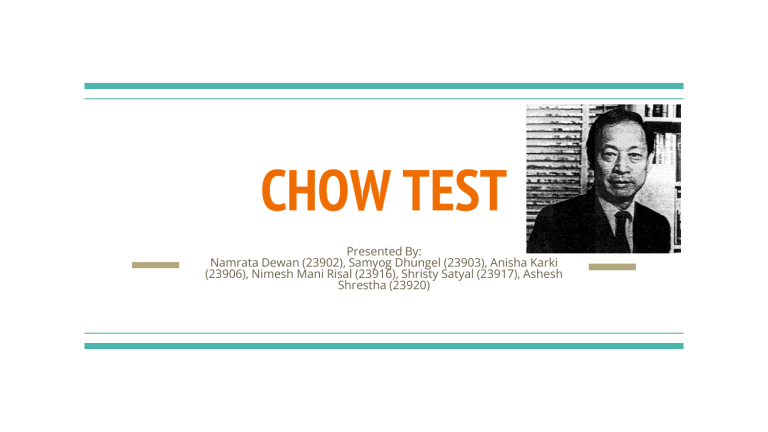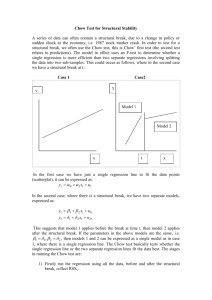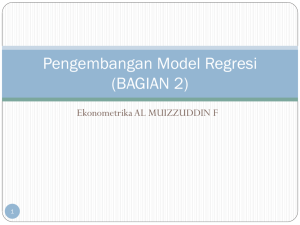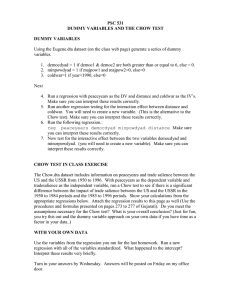
CHOW TEST Presented By: Namrata Dewan (23902), Samyog Dhungel (23903), Anisha Karki (23906), Nimesh Mani Risal (23916), Shristy Satyal (23917), Ashesh Shrestha (23920) WHAT IS CHOW TEST? A statistical method that checks whether variables of two different regression models are equal. Primary purpose: To determine if any structural change occurs between these variables. Used mostly for TIME-SERIES and CROSS-SECTIONAL DATA. Test depends on : k-distribution and includes a null and alternative hypothesis. HOW TO PERFORM CHOW TEST? FORMULA: Where, RSSR = RSS3 i.e. Restricted residual sum of squares for combined line RSSUR= RSS1+RSS2 i.e. RSS of two separate lines (Unrestricted) n1 and n2 = No. of samples k = Degree of Freedom PERFORMING CHOW TEST This table gives data on disposable personal income and personal savings, in billions of dollars, for the United States for the period 1970–1995. It is well known that in 1982 the United States suffered its worst peacetime recession. The civilian unemployment rate that year reached 9.7 percent, the highest since 1948. An event such as this might disturb the relationship between savings and DPI. To see if this happened, let us divide our sample data into two time periods: 1970–1981 and 1982–1995, the pre- and post-1982 recession periods. Ho = There is no structural change. Ha = There exists a structural change COMBINED REGRESSION Yc = 62.42267 + 0.0376791 Xc + uc RSS = 23248.3 , RSSR = 23248.3, df = 24 Observation Savings (Y) Income (X) Observation Savings (Y) Income (X) 1970 61 727.1 1983 167 2522.4 1971 68.6 790.2 1984 235.7 2810 1972 63.6 855.3 1985 206.2 3002 1973 89.6 965 1986 196.5 3187.6 1974 97.6 1054.2 1987 168.4 3363.1 1975 104.4 1159.2 1988 189.1 3640.8 1976 96.4 1273 1989 187.8 3894.5 1977 92.5 1401.4 1990 208.7 4166.8 1978 112.6 1580.1 1991 246.4 4343.7 1979 130.1 1769.5 1992 272.6 4613.7 1980 161.8 1973.3 1993 214.4 4790.2 1981 199.1 2200.2 1994 189.4 5021.7 1982 205.5 2347.3 1995 249.3 5320.8 REGRESSION : PRE- 1982 Ya= 1.016115 + 0.0803319Xa + ua RSS1= 1785.03254, df = 10 REGRESSION: POST - 1982 Yb = 153.4947 + 0.0148624 Xb + ub RSS2 = 10005.2214, df = 12 RSSUR= RSS1 + RSS2 = 11790.25394 CALCULATING F VALUE USING CHOW TEST F = (23248.3 - 11790.25394) / 2 (11790.25394) / 22 Hence, F = 10.69, and from F-Table, Fo= 5.72. Since F > Fo, we can assume to alternative hypothesis that the savings-income relation has undergone a structural change. F-TABLE (SIGNIFICANCE 0.01) Drawbacks ● ● ● ● ● ● Sensitivity to Breakpoint Specification Dependence on Sample Size Difficulty in Interpreting Breaks Lack of Robustness No Information on Magnitude Limited to Linear Regression




